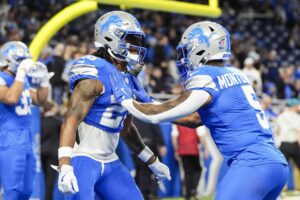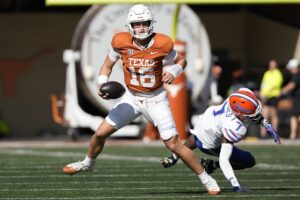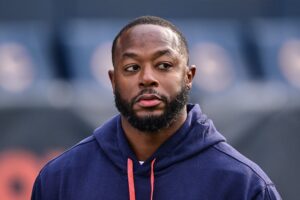Jadeveon Clowney was once a generational prospect, hyped as one of the best edge-rushers of the past decade before being selected first overall by the Houston Texans in the 2014 NFL Draft. Still only 27 years old, Clowney entered the 2020 off-season with high expectations for a lucrative contract. Instead, he remains unsigned, with teams in need of a pass-rusher opting for cheaper options, such as Dante Fowler. This raises a couple of questions: 1) How did Clowney go from a generational prospect to a forgotten free agent, and 2) Is it worth it to invest cap space and draft capital into such prospects? Let’s take a deep dive into Clowney’s career to evaluate his performance to find out why he’s become an after-thought in free agency and debate the merits of drafting a pass-rusher in the top three.
Jadeveon Clowney: Going From Generational Prospect to Forgotten Free Agent
Scouting Report
Jadeveon Clowney had the total package as an edge-rushing prospect: elite athleticism, college production, and positional versatility. This was an extremely disruptive player with a 6’5, 266-lb frame and 4.53 speed. NFL.com’s Nolan Nawrocki described him as a “physical specimen with a rare size-speed combination” who can “split the double team” and “collapse the corner” or “rag-doll blockers.” There were questions about Clowney’s effort level, but this was a player who was the consensus number-one prospect, ahead of players like Khalil Mack and Aaron Donald. So what happened to Clowney, why are teams passing him up? Let’s move onward to his production as a pro.
Injury Issues
Clowney’s production has been a bit underwhelming as a pro. This was a player who was projected to rack up double-digit sacks each year, but he’s failed to eclipse that number in any of his seven seasons. Part of this has been due to injuries, which have kept him out of games and impacted his play. He tore his meniscus twice in his rookie season, which caused him to miss 12 games. He had a Lisfranc injury on his foot following the 2015 season. He’s also coming off a season where he played with a core muscle injury that limited him to only three sacks. This injury required off-season surgery, which raises a red flag for future suitors. Having said that, he’s still been a productive player – he’s compiled over 15 tackles for loss in three seasons while registering 9 sacks on two occasions. The Texans were forced to trade him to the Seattle Seahawks, deciding to secure an asset for a player likely to depart in free agency. These demands have influenced his lengthy stay in free agency
Contract Demands
Clowney was originally seeking a deal worth in the upwards of $20 million per year but has now lowered this number to about $17 million per year, as teams have refused to meet these contract demands. The top five highest-paid edge-rushers in the NFL are Khalil Mack ($23.5M per year), Demarcus Lawrence ($21M per year), Frank Clark (20.8M per year), Von Miller (19.083M per year), and Trey Flowers (18M per year). Each of these players has multiple seasons with double-digit sacks, except for Flowers, who was overpaid by his former coach Matt Patricia and the Detroit Lions. It’s clear that Clowney’s new expectations are more aligned with his production, but he’s still having difficulty generating much interest on the free agent market. There’s another red flag that has caused teams to avoid paying up to acquire his services.
Character Concerns
There are some people around the NFL who have questioned Clowney’s commitment, concerned that this is the type of player who won’t put forth the same effort after cashing in with a lucrative contract. This type of questioning dates back to 2014 NFL Draft process, with prominent analysts like current Oakland Raiders general manager Mike Mayock stating that there are “red flags” in his work ethic. Even Steve Spurrier, his college coach at South Carolina, stated that Clowney’s work ethic was underwhelming. Whenever such criticism follows a player throughout his career, it’s likely that there’s at least some truth to such remarks.
Worth the Investment?
It’s tough for teams to invest such high capital in an edge-rusher who hasn’t put up elite sack totals and has consistently disappointed with his effort level. When you also consider his lengthy injury history, it’s difficult to see the viability of this investment. The best fit for Clowney would be on a contending team with a strong culture and winning track-record, such as his former team, the Seattle Seahawks. The Tennessee Titans have shown interest in Clowney – an improving team with a hard-nosed approach, they would also be a suitable destination. Add in the fact that Titans’ head coach Mike Vrabel coached Clowney as his defensive coordinator in Houston and you have an ideal match.
Worth the Draft Capital?
The fact remains that Jadeveon Clowney is still only 27 years old, but he’ll likely be playing for his third team in three seasons. This raises the question, should teams invest top-three draft picks into edge-rushers? As good as Clowney played for Houston, we can’t consider the pick a success, seeing how he only lasted five seasons with the team. While Joey Bosa and Nick Bosa have been smash-hits for the Los Angeles Chargers and San Francisco 49ers, these were teams who already had capable starting quarterbacks. Myles Garrett has played well, but Baker Mayfield has been inconsistent, so the Cleveland Browns have not made the playoffs. Ndamukong Suh and Gerald McCoy were great players, but they have since departed their drafted teams after a few seasons without any playoff victories. Chris Long went on to win Super Bowls as a depth player for the New England Patriots and Philadelphia Eagles. It’s more likely that a top-three pass-rusher ends up leaving their drafted team after only a few seasons rather than leading that team to a Super Bowl. It’s simply not worth the investment for a quarterback-needy team to draft a generational pass-rusher because that player could wind up as a forgotten free agent, just like Clowney.
Main Photo:
Embed from Getty Images






